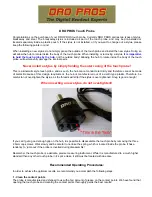
409-32048
Rev A
38
of 64
In other modes, the state of these buttons (outputs) is controlled by the main conveyor controller
(mounted under the tabletop). The input displays are always active.
2. The
Run motor
button turns the main conveyor belt motor on and off. The
Reverse direction
button
toggles the belt direction from left-to-right to right-to-left (reverse).
NOTE
The main conveyor PCB transport belt can only be jogged forwards and backwards with these buttons when the main
conveyor Mode is set to ‘Manual’. And it’s important to remember the current Conveyor mode when switching from it to
‘Manual’ –
you will need to switch back!
In other modes, the state of these buttons (outputs) is controlled by the main conveyor controller
(mounted under the tabletop). The ‘PCB at hard stop’ and ‘PCB at rear’ input displays continuously
indicate the status of the two (2) main conveyor PCB fiber thru-beam sensors. 'At hard stop' indicates
that a PCB is present at the pressing position. 'At rear' indicates a PCB is at the end of the main
conveyor or output Conveyor Extension and is ready for transfer to the next machine or operator
removal, or is ready to be loaded in Reverse Shuttle Mode.
3. The
Run motor
button turns the infeed conveyor belt motor on and off. The
Reverse direction
button
toggles the belt direction from left-to-right to right-to-left (reverse).
NOTE
The infeed conveyor PCB transport belt can only be jogged forwards and backwards with these buttons when the infeed
con
veyor Mode is set to ‘Manual’. And it’s important to remember the current Conveyor mode when switching from it to
‘Manual’ –
you will need to switch back!
In other modes, the state of these buttons (outputs) is controlled by the infeed conveyor controller
(mounted under the tabletop).
The ‘PCB at front’ and ‘PCB at exit’ input displays continuously indicate
the status of the two (2) infeed conveyor PCB fiber thru-beam sensors. 'At front' indicates that a PCB
is present and ready to be staged. 'At exit' indicates a PCB is staged and ready for transfer to the
main conveyor.
4. The input and output devices are usually other SMEMA-compliant PCB processing equipment, or
conveyor buffers. The press can also be used in a stand-alone configuration where the
PCB’s are
loaded and unloaded at the output of the main conveyor (Reverse Shuttle Mode). The 'Input device
Board Available' display indicates if a PCB is available to be loaded from the upstream machine. The
'Output device Not Busy’ display indicates if th
e output machine is ready to receive a PCB from the
press.
The Machine Not Busy
button toggles the status of the output to the upstream device. The
Board Available
button toggles the status of the output to the downstream device.
NOTE
These buttons can only be used when the appropriate co
nveyor mode is set to ‘Manual’.
And it’s important to remember the
current Conveyor mode when switching from it to ‘Manual’ –
you will need to switch back!
In other modes, the state of these buttons is controlled by the appropriate conveyor controller. The
‘Input device Bad Board’ display and ‘Bad Board’ output button are only provided for future SMEMA
functionality.
5. The
Enable Load, Enable Unload
and
Clear
buttons initiate the respective low level functions in the
appropriate conveyor controller. The
Load Board
and
Unload Board
buttons execute the same high
level manual load or unload functions used for normal operation, as described above.
6.
The ‘Mode’, ‘Status’ and ‘Error’ displays are intended for low
-level troubleshooting of the conveyor
controllers by factory trained personnel.
7. These are the basic conveyor belt motor parameter values.
‘Speed’ is the belt motor speed in
steps/second and ‘Accel’ is the belt motor accel
eration in steps/second*second. These values can be
increased to reduce PCB load/unload time or reduced to avoid jostling of the unpressed connectors or
other components on the PCB.
NOTE
Speed should never be set greater than two times acceleration. Certain combinations of speed and acceleration may produce
noisy or jerky motion with a particular load, particularly at lower values. If this is encountered while adjusting these values, try
different combinations.
















































